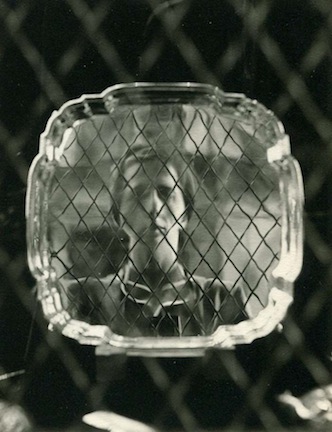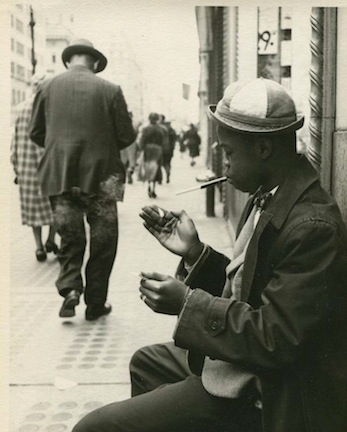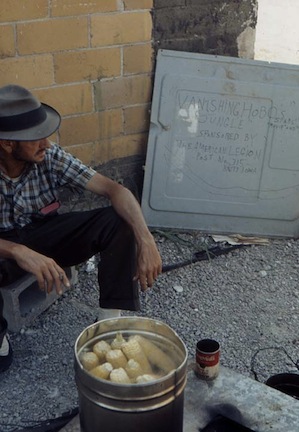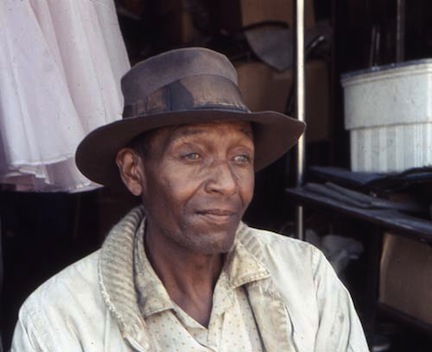Getting the Right Angle on Vivian Maier (original) (raw)
Feature Thu Jan 06 2011

A self portrait by Vivian Maier; photo courtesy of Ron Slattery
By now you may have heard about Vivian Maier, the secretive North Side nanny with a French accent and bad manners whose astonishingly prolific habit of taking really good photographs has earned her posthumous fame. Her story was featured in Chicago Magazine, on "Chicago Tonight," the Suntimes and dozens of blogs just in the past two weeks. Since her death in April 2009, her work has been exhibited around the world, with an exhibition opening at the Cultural Center this Friday.
Maier is not the only one getting famous off her photographs, though, because the story of their discovery is almost as exciting as the photographs themselves. According to legend, a young real estate agent and third-generation flea market seller named John Maloof stumbled across a box of Maier's negatives at an estate auction at the RPN auction house in 2007, put in an absentee bid, and won it for $400 with the hope of using some of the images for a book he was putting together about Portage Park. After a swift run-through of his winnings, he found nothing he could use for the book, so he stashed them away for a few months. Later, when he was able to spend some quality time with the photos, he found himself captivated.
"I thought at first that my interest in her work was just an unusual obsession," he said. "People who were much bigger experts in the field told me that there was nothing unique about this work. Given that I was a real estate agent, I initially took them at their word."
One person Maloof was in contact with, however, shared his passion for the photos. And this is where the legend gets a little weird.

Ron Slattery, an old friend of Maloof's brother, has been collecting vernacular photography for years and sharing it on a website he created in 2004 called Big Happy Funhouse. He was at the auction in 2007, too, and he also bought a few lots of Maier's film. On July 22, 2008, Slattery posted six of these photos on his site. He is convinced that if you Googled "Vivian Maier" that fall, you would have found them. Maloof, however, maintains that he Googled her and came up with nothing concrete until May 2009, when her obituary was published in the Chicago Tribune. The Vivian Maier blog Maloof created, as well as several stories of the discovery that have made it into the press, state that he hadn't found her name on the slides and/or hadn't gotten around to Googling her until after her death, but Slattery insists (and Maloof admits) that isn't quite true.
"I really wish I'd been clearer when I first wrote her story on the blog. I searched the name Vivian Maier numerous times, in lots of different keyword variations, but nothing concrete came up until I found her obituary," Maloof explained. "I've thought about rewording it, but am apprehensive that it might make it seem like I'm rewriting the story."

According to Slattery, between that first auction in 2007 and Maier's death in 2009, he and Maloof were emailing back and forth about Maier and he was giving Maloof advice about the Vivian Maier website. Being one of the legions of uninsured Americans, Slattery found himself in need of quick cash to pay mounting medical bills, and sold Maloof a good portion of his collection of Maier's film -- 1,000 rolls of film at $1 apiece, according to Maloof.
[EDITOR'S NOTE: Slattery emailed to clarify this statement. "I sold those rolls to John at such a cheap price because he was a friend. He seemed genuinely interested in Vivian's work. I called Nick from Squareamerica.com and asked his advice. We both realized that I didn't have the resources to develop the work and getting healthy was more important. ... There was a reason I did it. He was a friend. Also, I developed some of the rolls of film. Well before I gifted them to John. I still have those first proof sheets and negatives. I sold them to John because I was helping a friend with a project." ]
Now Maloof appears to have teamed up with another collector of Vivian Maier's work, Jeff Goldstein, who has created his own website about Maier. And now that the story of Maier is getting big, Slattery is unnerved by the way Maloof and Goldstein seem to be cutting him out of the picture.
"The site states that they are setting themselves up as the validators of Vivian's work," Slattery said, "and I am worried they are trying to cut me out. I don't want to be in the position to have to prove I have the real thing later when they all know I do now. I even sold Jeff [Goldstein] some prints."
Slattery says at one point Maloof had acknowledged his help on the Vivian Maier Flickr post he created when he first dug into her work, but the kudos have since been edited off.
"It's weird, isn't it?" Slattery mused on the highly entertaining and informative Metafilter page about the discovery. "I think John was just giving a 'P.T. Barnum spin' to his story."
This is possible, sure. It could be a publicity tactic. The thing that everyone seems to agree on, though, is that they're glad Maier's work is getting publicity in the first place.
By the time she retired, Vivian Maier had collected boxes upon boxes of slides, prints, home movies, and audio interviews that she had conducted while she was nannying. According to Slattery, they filled at least a half dozen 10' x 20' storage units. At some point while she was sick in a nursing home, she fell behind on the payments and the contents were sold to the RPN auction house. Although it is a shame that she lost her work while she was still alive, and never even developed thousands of rolls of film to see the fruits of her labor for herself, we are lucky they fell into the hands of avid collectors and photography enthusiasts like Maloof and Slattery, who are giving her work the exposure it deserves (pun intended) -- not just through exhibitions and books, but through a documentary film as well. Her ceaseless, bordering on obsessive documentation of the 20th century can now be enjoyed and appreciated worldwide for centuries to come.
Would this intensely private woman have wanted her work to go public? Nobody can say. But you've got to admit, if she really didn't want them out there she probably wouldn't have saved them. We can only hope she was saving them for us.

~*~
This feature is supported in part by a Community News Matters grant from The Chicago Community Trust and the John S. and James L. Knight Foundation. More information here.
